Janet Hulstrand's Blog
September 25, 2025
Interview with Sidonie Bilger, Artiste
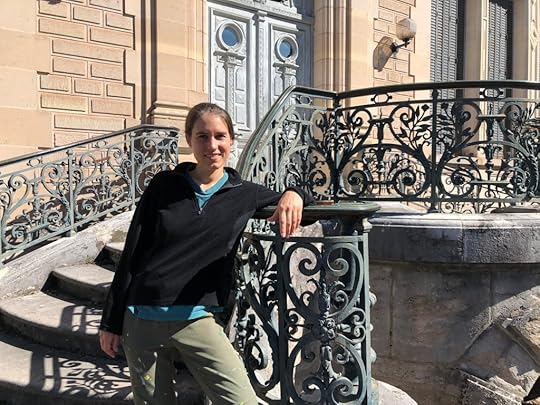 Sidonie Bilger, lauréate du 2025 Bourse Renoir, au Château Hériot, Essoyes. Photo by Janet Hulstrand.
Sidonie Bilger, lauréate du 2025 Bourse Renoir, au Château Hériot, Essoyes. Photo by Janet Hulstrand.Sidonie Bilger est la lauréate 2025 de la Bourse Renoir, parrainée par l’Association Renoir en partenariat avec la Mairie d’Essoyes (Aube) et le site culturel Du Côté des Renoir. Elle a étudié le dessin, la peinture et la gravure à l’École Emile Cohl á Lyon et à la Hochschule der Bildenden Künst Saar en Allemagne, et elle est diplômée de l’École Nationale Supérieure des Beaux-Arts de Paris. Ses œuvres les plus récentes seront exposées au Manoir Champagne Devaux à Bar-sur-Seine du 3 octobre-1 novembre; puis à la Salle d’Exposition du Crédit Agricole à Troyes (269 Rue du Faubourg Croncels, 10000 Troyes) le 5 -25 novembre. J’ai récemment rencontré Sidonie lors d’une journée portes ouvertes au Château Hériot à Essoyes, où elle travaille sur ses dernières peintures, et elle a gentiment accepté de répondre à quelques questions sur sa vie d’artiste et son travail. Cette interview a été réalisée (principalement) par e-mail, en français et en anglais.
VERSION FRANCAISE (Scroll down for the English version).
Janet Hulstrand: Où as-tu grandi ? Et où vis-tu maintenant ?
Sidonie Bilger: J’ai grandi en Alsace avec mes parents et mon frère, dans un village-dortoir entre Mulhouse et Bâle. Très vite, je suis partie en internat à l’âge de 15 ans vers Strasbourg pour faire mes études. Aujourd’hui, je suis nomade : je vais de résidence d’artistes en résidence d’artistes, de projets en projets. Cela m’amène à déménager très régulièrement, je découvre ainsi plein de régions en France et parfois même à l’étranger. Il m’est arrivé de vivre en Allemagne dans ce cadre, ou de voyager jusque dans les Antilles françaises. Pour des raisons administratives liées à mon activité, j’ai quand même une adresse fixe en Haute-Saône, dans la très belle région des Mille-Étangs. Mes parents me laissent à disposition une roulotte ainsi qu’un grand espace d’atelier et de stockage.
Quelle importance accordez-vous au lieu (urbain/rural, type de paysage, etc.) dans votre travail ?
Plus jeune, j’ai peint beaucoup de paysages. Je peignais sur le motif en extérieur, je n’avais pas toujours d’atelier et c’était pour moi un moment où j’étais en connexion avec le réel, avec la lumière. Je faisais mes gammes en marchant dans les pas d’artistes modernes dont j’aimais énormément le travail.
Aujourd’hui, le lieu n’est jamais un simple décor dans mon travail, il en constitue la matière première. Qu’il soit urbain, rural, industriel ou naturel, chaque territoire porte des traces visibles et invisibles : vestiges, récits, luttes sociales, imaginaires collectifs. Je m’attache à les écouter et à les transformer en images. Dans un paysage industriel en friche, ce sont les mémoires ouvrières et les fantômes des machines qui nourrissent mes fresques. Dans un espace rural, ce sont les tensions contemporaines entre agriculture, écologie et mutation des modes de vie. L’urbain, quant à lui, est à la fois un terrain d’affichage, un espace de friction sociale et une scène où l’art peut entrer en résonance directe avec le quotidien.
Chaque contexte me pousse à ajuster ma pratique : le dessin monumental devient fresque dans l’espace public, collage dans la rue, ou installation immersive dans un lieu clos. Le paysage et l’histoire locale déterminent la forme, mais aussi le sens de l’œuvre. En ce sens, le lieu n’est pas secondaire : il est le point d’ancrage qui permet d’articuler mémoire, imaginaire et engagement.
Depuis combien de temps êtes-vous à Essoyes ? Qu’avez-vous le plus apprécié ici ?
Je suis arrivée à Essoyes le 3 août 2025. L’architecture calcaire et les paysages me rappelaient un peu la Haute-Marne, où j’ai vécu un temps et dont j’ai beaucoup peint les paysages. Mais j’ai été particulièrement fascinée, dans ce village, par la présence de l’eau, cette rivière qui coupe le village en deux. Ensuite, le village m’a touchée dans son initiative autour de la culture. Peu d’habitants y vivent mais j’y ai rencontré un vrai engouement pour la peinture.
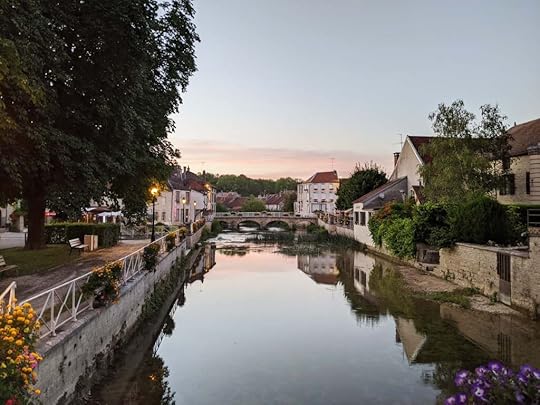 L’Ource River à Essoyes. Photo by Phineas Rueckert.
L’Ource River à Essoyes. Photo by Phineas Rueckert. Quand avez-vous su que vous vouliez devenir artiste ? Et comment l’avez-vous su ?
Plus jeune, je ne savais pas que le métier d’artiste en arts visuels existait. J’ai toujours aimé dessiner. Je voulais devenir une grande dessinatrice. Je dis souvent que je faisais comme tous les enfants, je dessinais tout le temps, mais que, contrairement à la plupart des adultes, je n’ai jamais arrêté. Lorsqu’il a fallu faire un choix pour mes études, j’ai tenu tête à mes parents et je me suis orientée vers des études artistiques. À l’époque, c’était dans le domaine du stylisme ou du design, je m’orientais maladroitement vers les arts appliqués. Très vite, j’ai compris que ce n’était pas ce que je voulais faire, que ça ne me correspondait pas.
Quand j’ai eu 20 ans, j’ai rencontré un peintre lors d’une conférence. C’est à ce moment que j’ai découvert ce qu’était un artiste et j’ai compris que c’était dans cette direction que j’allais. Avec le recul, je me souviens qu’un professeur d’histoire de l’art m’avait dit que je n’avais rien à faire en arts appliqués. Je l’avais très mal pris, j’étais assez têtue, mais il avait raison. C’est juste qu’à l’époque, pour moi, les artistes peintres appartenaient à un temps passé.
 Sidonie sharing her work with students. Photo used with permission of the artist.
Sidonie sharing her work with students. Photo used with permission of the artist.Qu’est-ce qui est le plus important pour vous en tant qu’artiste ? Comment décririez-vous vos principaux objectifs dans la création de votre œuvre ?
Ce qui compte le plus pour moi en tant qu’artiste, c’est de donner forme à ce qui traverse notre époque : les crises écologiques, les fractures sociales, mais aussi les récits et les mémoires qui tissent un territoire. Mon travail cherche à rendre visibles ces tensions, à la fois dans leur dureté et dans leur force de résistance.
L’envie de créer une œuvre naît très souvent chez moi d’un sentiment d’injustice. C’est en quelque sorte toujours une forme de révolte. Je vais chercher, dans les interstices des rencontres et des lieux qui m’accueillent, une histoire qui va m’animer, dans laquelle je vais sûrement me reconnaître et par laquelle je vais essayer de créer du dialogue. J’essaie de créer des images qui dépassent la simple contemplation : des fresques, des dessins monumentaux ou des projets collectifs qui ouvrent un espace de réflexion et de partage. Je veux que l’œuvre soit un lieu de rencontre entre l’individuel et le collectif, entre le sensible et le politique.
Au fond, ma recherche vise à inventer des formes où la beauté et la catastrophe coexistent, pour faire émerger de nouveaux récits communs et nourrir de nouveaux imaginaires.
 Sidonie Bilger with some of her current works in progress au Château Hériot, Essoyes. Photo used with permission of the artist.
Sidonie Bilger with some of her current works in progress au Château Hériot, Essoyes. Photo used with permission of the artist.Quel est le défi le plus difficile à relever en tant qu’artiste ? Qu’est-ce qui est le plus épanouissant, le plus joyeux dans ce métier ?
Le métier d’artiste est très complet et complexe, et sûrement complètement différent d’un artiste à l’autre. Pour ma part, les défis dans la création sont évidents : l’exigence que l’on porte à son travail, les doutes qui nous traversent, la solitude également. Mais il y en a aussi dans tout le reste à côté : les concours, et les dossiers de candidature, la communication, les réseaux sociaux, la gestion d’entreprise, la connaissance et le respect de ses droits, les négociations avec les différents interlocuteurs, la compétition. C’est un monde malheureusement, à certains égards, implacable, et très concurrentiel.
Ce que j’aime dans mon métier, ce sont les voyages qu’il me permet de faire. Mais ce que j’apprécie le plus, c’est quand la peinture me donne accès à des moments de joie, de connexion profonde. Quand mes œuvres parlent au regardeur, je ressens une exaltation intense, mêlée d’espoir, et l’impression d’une force collective qui dépasse l’individuel.
 Sidonie Bilger au travail dans le Château Hériot, Essoyes. Photo used with permission of the artist.
Sidonie Bilger au travail dans le Château Hériot, Essoyes. Photo used with permission of the artist.Selon vous, qu’est-ce que beaucoup de gens ne comprennent pas à propos de la peinture ou du travail des peintres, et qu’il est important pour eux de comprendre ?
Beaucoup de gens pensent encore que la peinture est une pratique tournée vers la décoration ou la simple virtuosité technique. Or, peindre, ce n’est pas seulement produire de « belles images », c’est avant tout une manière de penser, de prendre position et d’ouvrir un espace critique. Pour moi, c’est extrêmement important et c’est ce qui est si risqué. Les œuvres d’art les plus importantes de l’histoire de l’art sont aussi celles qui, souvent, ont créé les plus grands scandales.
Le travail d’un peintre engage du temps, une recherche, une relation au monde qui est autant intellectuelle que corporelle. C’est une pratique qui n’est pas isolée de la société : elle dialogue avec l’histoire, l’actualité, les luttes, les imaginaires collectifs. Il est important de comprendre que la peinture n’est pas figée dans le passé. Elle reste un langage vivant, capable d’inventer de nouvelles formes et d’exprimer les tensions les plus brûlantes de notre époque.
Y a-t-il un ou plusieurs thèmes particuliers sur lesquels vous vous concentrez dans votre travail récent ?
Oui, mon travail récent se concentre sur des thèmes liés au collectif et aux formes de résistance. Je m’intéresse au carnaval comme espace de métamorphose et de révolte, où l’anonymat du masque permet de faire émerger des voix multiples. J’explore des imaginaires collectifs hybrides, entre beauté et chaos, qui questionnent notre époque marquée par les crises écologiques, les héritages coloniaux absurdes et la catastrophe en cours, face à laquelle ma génération se sent souvent impuissante.
Je cherche à traduire plastiquement cette tension entre effondrement et désir d’avenir, en inscrivant l’art dans une dynamique de groupe, de partage et de contestation. La question féminine, et plus largement celle de la déconstruction des rapports de domination, traverse aussi mon travail : elle m’amène à inventer des formes où les identités peuvent se transformer et se libérer.
 Sidonie Bilger with one of her recent paintings. Photo by Janet Hulstrand.
Sidonie Bilger with one of her recent paintings. Photo by Janet Hulstrand.Avez-vous des projets futurs ou des pistes d’exploration que vous aimeriez faire connaître ?
Mon prochain temps fort sera une résidence de création et de médiation au lycée agricole de Bourges – Le Subdray. Le thème central de cette résidence tournera autour de l’animalité et de l’altérité. Je vais explorer comment ces notions peuvent ouvrir un dialogue entre les êtres humains, le vivant et le territoire, dans un lycée agricole, ce qui engage aussi l’écologie, l’éthique, la relation avec les autres formes de vie.
Par ailleurs, j’ai plusieurs projets de fresques à venir et je continue de postuler à de nombreux appels à projets et résidences pour étendre mon travail, tant en France qu’à l’étranger.
Janet Hulstrand est une écrivaine américaine qui habite en France. Elle est l’auteur de Demystifying the French: How to Love Them, and Make Them Love You, et A Long Way from Iowa: From the Heartland to the Heart of France. On peut trouver son écriture aussi sur Substack. Et vous pouvez en savoir plus sur les oeuvres et les activitiés de Sidonie Bilger sur son site.
ENGLISH VERSION
Sidonie Bilger is the 2025 recipient of the Bourse Renoir, sponsored by the Association Renoir in partnership with the Mairie d’Essoyes (Aube) and the cultural site Du Côté des Renoir. She has studied drawing, painting, and engraving at the Emile Cohl School in Lyon and the Hochschule der Bildenden Künst Saar in Germany, and she is a graduate of the École Nationale Supérieure des Beaux-Arts in Paris. Her most recent work will be exhibited at the Manoir Champagne Devaux in Bar-sur-Seine from October 3-November 1, and at the Crédit Agricole Salle d’Exposition in Troyes (269 Rue du Faubourg Croncels, 10000 Troyes) from November 5-25. I recently met Sidonie at an open house at the Château Hériot in Essoyes, where she is working on her latest paintings, and she kindly agreed to answer a few questions for me about her life as an artist and her work. This interview was conducted (mostly) via email, in French and in English.
Janet Hulstrand: Where did you grow up? And where do you live now?
Sidonie Bilger: I grew up in Alsace with my parents and my brother, in a commuter village between Mulhouse and Basel. I went to a boarding school near Strasbourg at the age of 15 to continue my studies. Today, I am nomadic: I move from artist residency to artist residency, from project to project. This requires that I relocate very frequently, and allows me to discover many regions in France and sometimes even abroad. I have lived in Germany in this context, and I’ve also traveled as far as the French Antilles. I still have a permanent address in Haute-Saône, in the beautiful Mille-Étangs region. My parents provide me with a trailer and a large space for a studio and storage.
How important is place (urban/rural, type of landscape, etc.) in your work?
When I was younger, I painted a lot of landscapes. I painted en plein air, often without a studio, and it was for me a moment of deep connection with the natural world, and with light. I practiced my techniques while following in the footsteps of modern artists whose work I admired greatly.
Today, the place where I am working is never just a backdrop in my work; it constitutes the raw material. Whether urban, rural, industrial, or natural, each territory carries visible and invisible traces: ruins, stories, social struggles, collective imagination. I try to listen to all this and transform it into images. In an abandoned industrial landscape, it is the memory of labor and the ghosts of machines that feed my murals. In a rural space, it is the contemporary tensions between agriculture, ecology, and changing ways of life. Urban spaces are places of display, zones of social friction, and stages where art can resonate directly with daily life.
Each context pushes me to adjust my practice: monumental drawing becomes a public mural, a street collage, or an immersive installation in an enclosed space. The landscape and local history determine both the form and the meaning of the work. In this sense, the place is not secondary: it is the anchor point that allows memory, imagination, and engagement to intersect.
How long have you been in Essoyes? What have you appreciated most here?
I arrived in Essoyes on August 3, 2025 and I will be here until October 3. The limestone architecture and landscapes here remind me a little of Haute-Marne, where I lived for a while and painted many landscapes. But what particularly fascinates me in this village is the presence of water, the river that cuts through the center of the town. I have also been touched by the village’s cultural initiatives. It’s not a very big population, but I have found here a genuine enthusiasm for painting.
When did you know you wanted to become an artist? And how did you realize it?
When I was younger, I didn’t know that being a visual artist was even a profession. I’ve always loved to draw. I wanted to become really good at drawing. I often say that, like most children, I drew constantly, but unlike most adults, I never stopped. When it came time to choose my studies, I stood my ground with my parents and oriented myself toward art studies. At the time, it was in the fields of fashion design or industrial design, and I was awkwardly exploring the applied arts. Very quickly, I realized that it wasn’t what I wanted, that it didn’t suit me.
When I was 20, I met a painter at a lecture. That’s when I discovered what being an artist truly was, and I realized this was the path I wanted to follow. Looking back, I remember an art history professor once told me I had no place in applied arts. I took it badly at the time—I was quite stubborn—but he was right. It’s just that, back then, I thought painters only belonged to the past.
What is most important to you as an artist? How would you describe your main objectives in creating your work?
The most important thing for me as an artist is to give form to what shapes our time: ecological crises, social fractures, as well as the stories and memories that weave a territory. My work seeks to make these tensions visible, both in their harshness and in the strength of their resilience.
The desire to create often arises from a sense of injustice. It is, in a way, always a form of revolt. I seek, between the encounters and the places in my surroundings, a story that animates me, in which I can recognize myself, and through which I try to create dialogue. I aim to produce images that go beyond mere contemplation: murals, monumental drawings, or collective projects that open a space for reflection and sharing. I want the work to be a meeting place between the individual and the collective, between the poetic and the political.
Ultimately, my research aims to invent forms where beauty and catastrophe coexist, to bring forth new shared narratives and nourish new ways of seeing our world.
What is the most difficult challenge as an artist? What is most fulfilling, most joyful in this work?
Being an artist is a complex, multifaceted profession, and is surely very different from one artist to another. For me, the challenges in creation are evident: the demands we place on our own work, the doubts we feel, and the solitude. But there are also challenges in all the rest of it: contests and applications, communication, social media, business management, understanding and standing up for one’s rights, negotiating with various stakeholders. It is unfortunately at times a harsh and highly competitive world.
What I love about my work is that it allows me to travel. But what I appreciate most is the moments of joy and of deep connection it brings me. When my paintings really speak to viewers, I feel an intense joy, a sense of hope–and the sense of a collective force that transcends the individual.
In your opinion, what do many people misunderstand about painting or the work of painters, and what is important for them to understand?
Many people still think of painting as a practice aimed at decoration or pure technical virtuosity. Yet painting is not just about producing “beautiful images”; it is above all a way of thinking, taking a position, and opening a critical space. For me, this is extremely important, and it is what makes it so risky. The most important works in art history are often those that caused the greatest scandals.
A painter’s work requires time, research, and a relationship with the world that is both intellectual and physical. It is a practice that is not isolated from society: it dialogues with history, current events, struggles, and the collective imagination. It is important to understand that painting is not frozen in the past. It remains a living language, capable of inventing new forms and expressing the most urgent tensions of our time.
Are there particular themes you focus on in your recent work?
Yes, my recent work focuses on themes related to collectivity and forms of resistance. I am interested in carnivale as a space of metamorphosis and revolt, where the anonymity of the mask allows multiple voices to emerge. I explore hybrid collective images–between beauty and chaos—that question our era, marked by ecological crises, absurd colonial legacies, and ongoing catastrophe, in the face of which my generation often feels powerless.
I seek to translate this tension between collapse and desire for the future, embedding art in a dynamic of group work, sharing, and protest. Feminist questions–and more broadly the deconstruction of power relations–also run through my work. They lead me to invent forms in which identities can transform and be liberated.
What’s next for you? Do you have upcoming projects or areas of exploration you’d like to share?
My next major step will be a creation and mediation residency at the agricultural high school in Bourges – Le Subdray. The central theme of this residency will focus on the relationship between humans and animals and the attempt to find new, and more positive ways of interacting with them. I will explore how these notions can open a dialogue between humans, the living world, and the earth, in an agricultural school setting, engaging ecology, ethics, and the relationship of humans with other forms of life.
In addition, I have several upcoming mural projects, and I continue to apply to numerous calls for projects and residencies to expand my work both in France and abroad.
Janet Hulstrand is an American writer/editor who lives in France. She is the author of Demystifying the French: How to Love Them, and Make Them Love You, and A Long Way from Iowa: From the Heartland to the Heart of France. You can also find her writing on Substack. And you can learn more about Sidonie Bilger’s work and follow her activities on her website.
September 14, 2025
Champagne: Spotlight on the Côte des Bars
This post is from a friend who spends half of his life in Minnesota, and half in Dijon. Wherever he goes, he appreciates good food and good wines–and he shares his extensive knowledge about these things on his blog. Merci, Jeff!
A Day at Champagne Vaucelle Remembered at Apéro #worldwinetravel
Janet Hulstrand is an American writer/editor who lives in France. She is the author of Demystifying the French: How to Love Them, and Make Them Love You, and A Long Way from Iowa: From the Heartland to the Heart of France. You can also find her writing on Substack.
May 8, 2025
Why is May 8 a holiday in France?
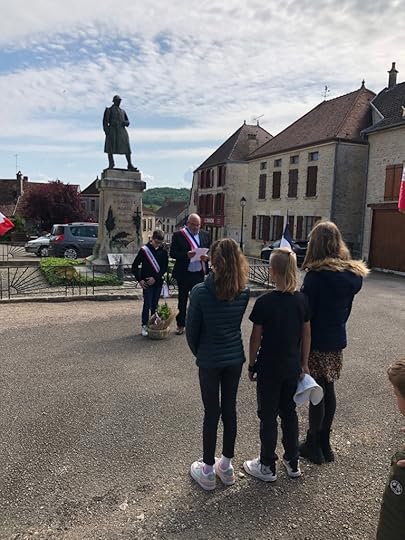

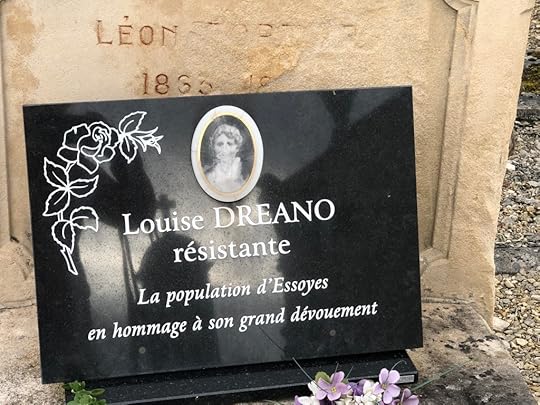
Well, it is more precisely a solemn day of commemoration than a holiday, or a jour de fête. For May 8, 1945, is the day that Germany surrendered to the Allies, and Europe was at last free of the Nazi nightmare they had lived through for more than a decade.
Each year in towns, cities, and villages throughout France, this day is remembered. In my village of Essoyes there is always a défilé through the town, from the mairie to the war memorial next to the church, where an official proclamation is read. This year, on the eightieth anniversary of V-E Day, the proclamation was signed by Sebastien Lecornu, Minister of the Armed Forces of France, and Patricia Miralles, Deputy Minister.
Today our mayor read this proclamation to the people of Essoyes–young, old, and in-betweens–who had gathered to honor this day. This is an excerpt of what he read:
“…Le sacrifice pour la Victoire avait été immense. Aux soldats morts, blessés, prisonniers; aux résistants foudroyés ou torturés, s’ajoutaient les civils assassinés et déportés, en particulier les Juifs morts dans la Shoah, ainsi que les champs de ruines laissés par les durs combats de la Libération. La France était meurtrie, mais un peuple entier avait survécu à l’une des pires épreuves de son Histoire grâce au soutien de ses alliés…” (You can read the rest of the message here.)
Then the names of every citizen of Essoyes who had sacrificed his life during World War II were read aloud by children of the village, and the sapeurs-pompiers, who were carrying the flag and standing at attention shouted Mort pour la France after each name was pronounced.
After that we all proceeded to the monument aux morts, and from there to two streets in the village named in honor of André Romagon and Maurice Forgeot, local résistants who were murdered by the Gestapo. In each of these places a minute of silence was observed, and flowers were left.
The names of the individuals featured on this page–Louise Dréano, André Romagon, Maurice Forgeot, Howard Season, Dick Rueckert, Charles E. Anderson–are but a few of the brave souls–French, Americans, Canadians, and others from around the world–who risked their lives to deliver France, and ultimately Germany and the rest of Europe as well, from the terrible fascist regime that had terrorized this continent. Horrific loss of life and untold quantities of additional suffering were required to regain the freedom that was lost when that regime took hold.
Today’s proclamation from the French Minister of the Armed Forces concludes “In a world where threats are multiplying, where ancient threats hover again over the country, and while international relationships are being reconfigured, let us remember the sacrifices that an entire generation of Frenchmen and women withstood to liberate the country, to rebuild it, and to give us back our sovereignty….” (That’s my emphasis  )
)
Would that the current threats to democracy and freedom that are hovering over us today, around the world, be pushed back without the need for such horrendous loss of life. So that we all might live better lives.
Is it too much to hope for?
 Lt. Howard Season, 2nd Bombadier Group, 15th US Air Force. MIA August, 1944
Lt. Howard Season, 2nd Bombadier Group, 15th US Air Force. MIA August, 1944
 Sgt. Dick Rueckert, medic in the U.S. Army’s 315th infantry regiment, 79th division. One American Veteran’s D-Day Story
Sgt. Dick Rueckert, medic in the U.S. Army’s 315th infantry regiment, 79th division. One American Veteran’s D-Day Story
 Flying Officer Charles E. Anderson, Royal Canadian Air Force, Killed in Action August 5, 1944, buried in Essoyes
Flying Officer Charles E. Anderson, Royal Canadian Air Force, Killed in Action August 5, 1944, buried in EssoyesJanet Hulstrand is an American writer/editor who lives in France. She is the author of Demystifying the French: How to Love Them, and Make Them Love You, and A Long Way from Iowa: From the Heartland to the Heart of France. You can also find her writing at Searching for Home.
April 27, 2025
A first close encounter with Joan of Arc…
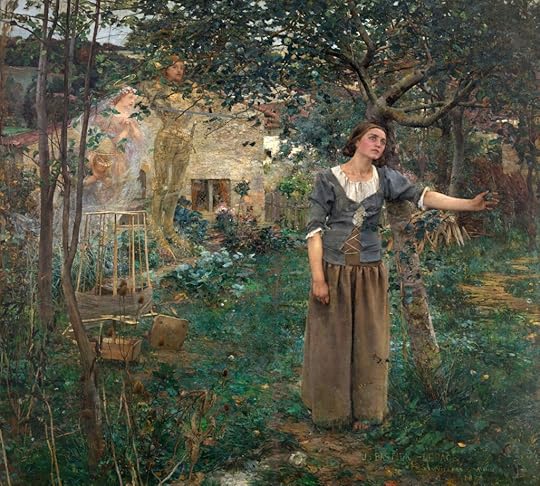 Jeanne d’Arc. Jules Bastien-Lepage, 1879. Metropolitan Museum of Art, New York.
Jeanne d’Arc. Jules Bastien-Lepage, 1879. Metropolitan Museum of Art, New York.The very first time I was in the Metropolitan Museum of Art in New York City I was there in the best of circumstances I can imagine. I was dropped off there in the morning by my boyfriend; and he told me he would pick me up sometime in the late afternoon.
Therefore, I was alone and left free to explore that amazing museum all by myself with no one else’s conflicting desires to interfere with my wandering through the collections, and no distraction of any kind by anyone else for quite a few hours.
I don’t remember a whole lot about what I did that day. I started by strolling through the antiquities. I probably spent a fair amount of time in the medieval section looking at the richly colorful paintings and sculptures. I think I took a lunch break in the café on the main floor. Then I went upstairs and began wandering through the galleries of European paintings.
When I rounded a corner and saw the painting you see above I stopped, and stood there for a long time. This painting of Joan of Arc at the moment she is being visited by the Archangel Michael and two female saints really spoke to me.
The description on Wikipedia says that this painting shows Joan at the moment that these spirits are “rousing her to fight the English invaders in the Hundred Years War,” and describes it as a moment of “spiritual awakening.”
To me it looks more like a moment of profound fear.
I mean, put yourself in the place of this simple country girl–she was in her early teens, between 13 and 15 years old–when these heavenly apparitions quite suddenly appeared in her parents’ garden and instructed her to undertake an incredibly dangerous mission that everyone, but everyone, was going to think was insane.
Wouldn’t you be afraid?
I have never forgotten this painting and though I haven’t spent all that much time thinking about Joan of Arc in the years since, when I moved to northeastern France, not too far from where she was born and raised, I began to idly think about taking a day trip sometime to see that place.
It was ten years before this idle thought became a reality, last week. I will be writing about that experience soon in the “Adventures in France” part of my Substack.
But for now I thought I would just share this bit of background on my interest in Joan of Arc. I can see already that a wonderfully intriguing “rabbit hole” of discovery awaits me.
It’s an incredible story, it really is. Stay tuned!
Janet Hulstrand is an American writer/editor who lives in France. She is the author of Demystifying the French: How to Love Them, and Make Them Love You, and A Long Way from Iowa: From the Heartland to the Heart of France. You can also find her writing at Searching for Home.
March 19, 2025
To Paris and Back (twice!) in a week…

I made the first of two trips to Paris in just a few days last week so that I could go to Adrian Leeds’s monthly Après-Midi meetup. This is one of my favorite things to do when I’m in Paris, and not infrequently I will even come in just for the day to see one of the speakers that is being featured.
This time the speaker was Scott Carpenter, who is a fellow Minnesotan, a fellow writer, and also a part-time resident of Paris. He is the author of two wonderful memoirs about his life in Paris, French Like Moi, and Paris Lost and Found. At this event he read from both of those books, and those who didn’t already know what a gifted–and also very funny–writer he is had the chance to find out. (Word to the wise: Adrian’s meetups are always recorded so if you missed an event but would still like to watch it, you can! Here’s the link to last week’s meetup. https://adrianleeds.com/upcoming-events/join-adrian-at-apres-midi/event-recap/ )
I went home the next morning, but just three days later Mary Duncan, author and publisher of Paris Writers Press, was hosting a lively literary soirée on Friday night, and I wasn’t about to miss that. So it was off to the train station in Vendeuvre once again, and on my way back to Paris.
I had a couple of free hours before going to the soirée and so I did it in my very favorite way to kill time. (Why do we use that expression, I mean really why do we?! I think it is very American in a not-so-great way. The French don’t talk about killing time–they are so big on enjoying it! But I digress…)
My favorite way to “kill time,” as I was saying, is to sit in a Parisian café somewhere, order something to drink, and then read and write in a leisurely way, and/or watch the passing parade. In a (French) word, to flâner.
This time I decided I wanted to find out what this “flat white” drink is that everyone is talking about these days. (True confessions of a country bumpkin, I had not even heard of it until a few weeks ago!) So I found a café that I figured might have it, and it did!
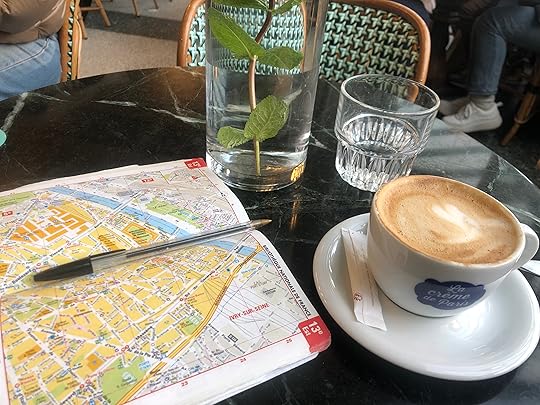

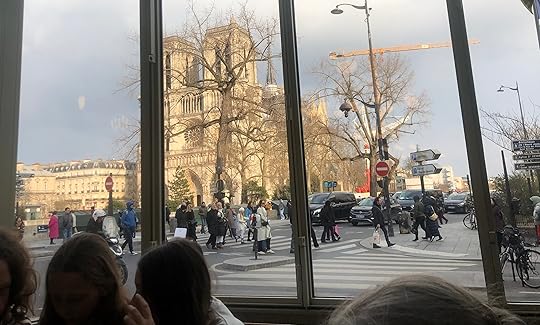
Samuél Lopez-Barrantes, a relatively new friend (and a brilliant writer!) was the featured guest at Mary’s soirée that evening, not only sharing information about his most recent book–The Requisitions, which all serious readers should read. I mean it!–but also performing a few of his beautiful songs.
His musical presentation was followed by an informal discussion Mary led about various publishing options in today’s publishing world. Among the guests was Odile Hellier, whose independent bookshop (the Village Voice) was an important–and wonderful–cultural institution in the literary world of Paris from 1982-2012. She recently published a memoir of not only her own very interesting life but the life of that bookshop as well. (Note: You can find Village Voices at your local indie bookseller (or order it from them), or you can get it on Bookshop.org.)
I do wish I had gotten a photo that evening with Mary, and with Samuél and his wife, Augusta Sagnelli, who is also his partner in their independent publishing company, Kingdom Anywhere, and a very talented and accomplished photographer as well. But that is just one of the things I hardly ever remember to do.  Oh well, next time!
Oh well, next time!
The next morning I was off bright and early to get my train back to Vendeuvre-sur-Barse, which is the closest place SNCF goes to “my” little village in southern Champagne. Normally this is a delightful, direct two-hour train ride from Gare de l’Est. However, as fate would have it, this particular day was a day when SNCF was doing track work. So I had to go home through Chalôns-en-Champagne, which is not at all on the way to where I live. Thus it was going to be a four-and-half-hour ride this time.
Which became even longer when the train was delayed by an hour getting started, due to a problem of alimentation éléctrique (a power outage) somewhere along the route.
Normally this is the kind of thing that might make me feel a bit cranky. But for some reason I decided this time to not get cranky, but just submit to my fate and see what this day would bring in the way of surprises–maybe even some of them pleasant surprises.
And guess what?! It brought a very pleasant surprise when it turned out that the lovely teenage girl sitting next to me on the bus from Chalôns to Troyes (the second leg in a three-leg journey) overheard me speaking English on my phone, and took the initiative to open a conversation with me. She is French, but she speaks English with an absolutely impeccable American accent. (I’ve honestly in my whole life never heard anything like it.) Apparently this is due to the fact that she has spent much of her young life in Canada, and also traveling a lot in the US and Canada with her very adventurous family. We had a wonderful time getting to know each other in the hour-long ride to Troyes, and I hope that maybe this will turn into one of those unexpected, serendipitous long-term friendships in the future.
But even if it doesn’t, what a wonderful way to turn a bad mood around, merci Lisa! 
By the time I got to Troyes, where I still had to figure out how to get the 35 kilometers from Troyes to Vendeuvre, where my car was waiting for me, I was in a fine mood to meet whatever challenge would still lie ahead.
But guess what? There was no challenge at all! Two SNCF employees approached the bus as we disembarked, and I asked one of them if he knew when the next bus would be going to Vendeuvre, since we had missed the regularly scheduled one.
“Pas de problème, madame,” he said to me. “Restez-là.” (Wait here). He located a couple who were also headed for Vendeuvre, and led us to a taxi that was to take us to the train station in Vendeuvre–courtesy of SNCF!
There’s a lot of complaining that goes on about SNCF in France, and I myself have occasionally been guilty of it. (Though mostly I love almost everything about SNCF.)
Also the French are (in)famous for not being very good about customer service. But if that isn’t service extraordinaire I swear I don’t know what is!
The taxi driver was friendly and kind, a real gentleman. He deposited the three of us at Vendeuvre, made sure we were set for the next leg of our journeys, and was on his way.
(PS: Do you know what SNCF stands for? It stands for Société Nationale des Chemins de Fer. If you speak French, say it aloud! I used to love reciting those words to my American students in Paris, to demonstrate just how lovely a set of words can be.  It is pure poetry!)
It is pure poetry!)
Janet Hulstrand is an American writer/editor who lives in France. She is the author of Demystifying the French: How to Love Them, and Make Them Love You, and A Long Way from Iowa: From the Heartland to the Heart of France. You can also find her writing at Searching for Home.
March 6, 2025
Apologies from an American in Europe
 Le coeur de Troyes, in the heart of Troyes (Photo by D. Le Nevé)
Le coeur de Troyes, in the heart of Troyes (Photo by D. Le Nevé)I was in Troyes, in northeastern France (in the Champagne region) on Wednesday, November 6. Which is the day we learned, most of us to our dismay and dread, that Donald Trump had been reelected as President of the United States.
I waited a couple of hours before allowing myself to believe that it was going to be true; that Kamala Harris was going to concede the election, that we would be faced with another Trump presidency.
But it was true, all right. And when I went into the Office de Tourisme in Troyes later that day to buy some pretty postcards like the one pictured above and the woman asked me (as a matter of course, for their records) what my nationality was, I said “Américaine.” And I added, “I’m so sorry for what we have done.”
We’ve only begun to see just how bad things are going to be this time around with this man as our president. It’s not looking good: not for the US, not for our neighbors and allies, not for all of Europe.
But I had certainly suspected it might be this bad: and that is why my first thought was to apologize to the first European who asked me about my nationality.
This choice was not mine. It was not the choice of many millions of Americans. (Probably more than the current records show. We’ll leave it to future historians to figure that out.)
But in the meantime, it’s clear that this presidency is a disaster not only for the US, but for much of the world. For many people in many other places around the world. Especially those who need the most help just getting along. Just simply surviving.
And so, I just want to say, on behalf of my fellow citizens–the millions of us who feel the way I do–that I am so sorry for the harm that has been caused already, and for the harm that still will be caused by this disastrous situation.
We are also embarassed, ashamed, and a bit fearful of what lies ahead.
But many of us–I hope most of us–will be working hard to stop the damage, to reverse and undo the damage, and to turn things around just as quickly as we can.
We will need help to do this. It is good to see European leaders stepping up, determined to meet the challenge of supporting Ukraine quickly and meaningfully in the wake of the sudden loss of the help of an important partner.
There’s lots of work to be done, in the US and abroad, to rescue and safeguard democracy from the clutches of the authoritarian types taking hold in various places, including in the United States. It isn’t going to be easy, and it won’t happen overnight. But history tells us that working together we can find a way through whatever lies ahead. People have done it before.
And there is some good guidance out there for what to do, and how to go about it. (Timothy Snyder, Lady Libertie, Robert Reich, to name just a few.) There are many others, and many of them are posting on Substack, and sharing on Bluesky, two relatively new social media sites not owned by oligarchs that are answering the need for a public space where people who believe in democracy can find ways to work together to save it.
We’re all in this together. This is no time to throw up our hands in dismay. It is time to roll up our sleeves, and get busy. There’s no time to waste.
Janet Hulstrand is an American writer/editor who lives in France. She is the author of Demystifying the French: How to Love Them, and Make Them Love You, and A Long Way from Iowa: From the Heartland to the Heart of France. You can also find her writing at Searching for Home.
March 2, 2025
A lovely weekend in Lille (Hauts de France)
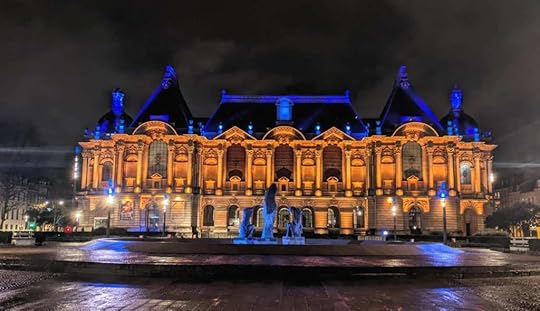 Musée des Beaux Arts, Lille. Place de la République. Photo by Phineas Rueckert.
Musée des Beaux Arts, Lille. Place de la République. Photo by Phineas Rueckert.Lille, the capital of the Hauts de France region, is a lovely city in the northeastern tip of France’s “Hexagon.” Located very near the Belgian border, Lille has been a major center of government, higher education, art, culture, and commerce for hundreds of years. It was the capital of Flanders until Flanders became part of France in the late 17th century. Today it continues to be a thriving urban center, with convenient transportation links to Paris, London, Brussels, and Amsterdam.
I’ve had the pleasure of visiting Lille several times in recent years because one of my sons lives there. This weekend my other son and I went there again, this time to watch him perform with his new band, Samjo.
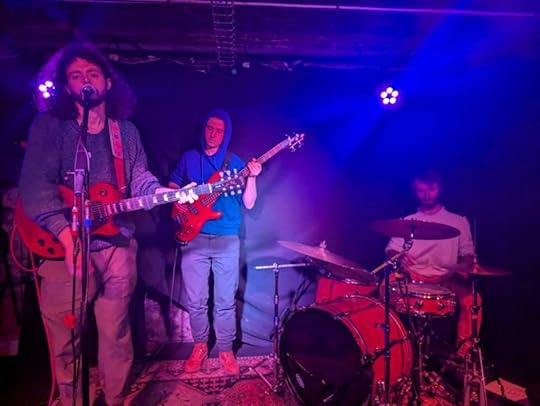 Samjo in Concert at La Griffe
Samjo in Concert at La GriffeIt was a very exciting night not only because this was the band’s first live performance, but because the energy was everything you could want for a first-time gig: a full house, an enthusiastic crowd, and talented musicians performing in perfect harmony, and in synch with one another. My son calls his niche “introvert rock.” His songs feature soulful, poetic reflections on life in a wide variety of its aspects, and from various points of view. As a lifelong lover of the French language, I am especially pleased that he’s mixing in some lyrics in French here and there.  Check out, for example, Night Lights. (The link provided is to Spotify, but you can access his songs pretty much anywhere music is streaming.)
Check out, for example, Night Lights. (The link provided is to Spotify, but you can access his songs pretty much anywhere music is streaming.)
There were other pleasures of course, and as always in France, one of those pleasures is eating.
 A hearty Hauts-de-France meal. Just the thing on a chilly winter night in northern France!
A hearty Hauts-de-France meal. Just the thing on a chilly winter night in northern France!We also had a lunch featuring galettes, which is a kind of thin buckwheat crépe (apparently Breton, not Flemish), in this case garnished with smoked salmon and filled with a hummus spread. It was delicious!
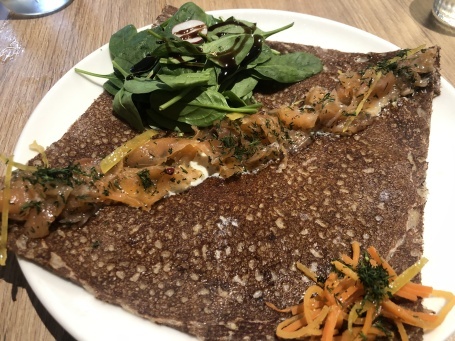
I also enjoyed reading, writing, and watching the world go by from a café while my sons worked, one at the school where he teaches, the other one at a café table not far away from me.
 Lillois (or are they tourists?) enjoying Lille on a rainy day. In the background, l’Opéra.
Lillois (or are they tourists?) enjoying Lille on a rainy day. In the background, l’Opéra.
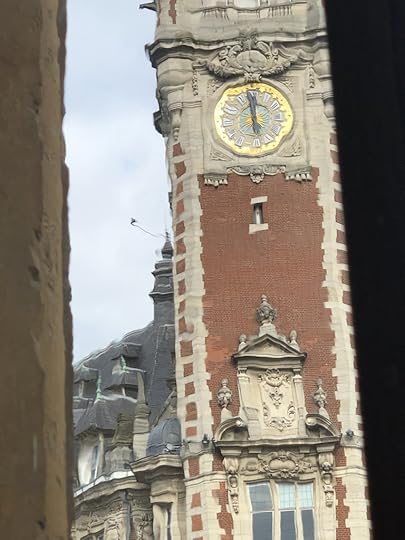 The clock tower seen through a rain-streaked café window.
The clock tower seen through a rain-streaked café window.Of course for me the best of all was just being with my two sons and having some nice time together. That was, as the silly commercial goes, priceless.
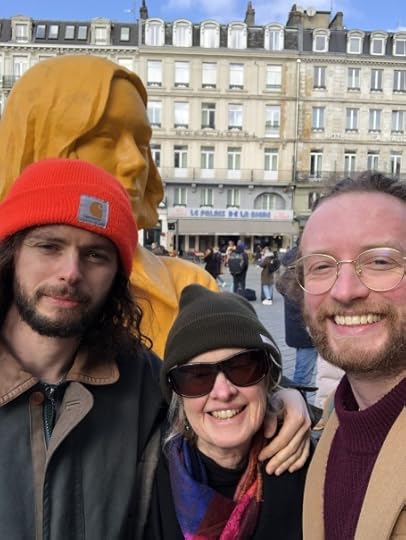
Janet Hulstrand is an American writer/editor who lives in France. She is the author of Demystifying the French: How to Love Them, and Make Them Love You, and A Long Way from Iowa: From the Heartland to the Heart of France. You can also find her writing at Searching for Home.
January 2, 2025
Spread Hope, Spread Joy
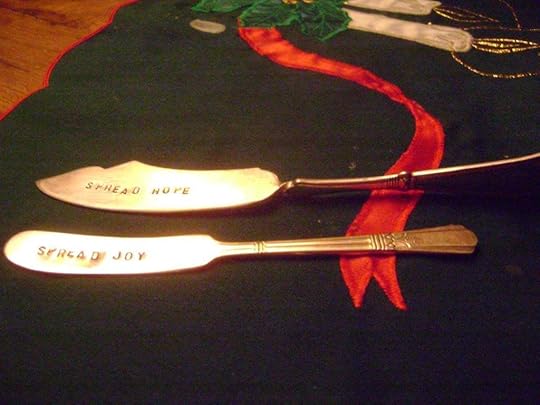
…and that is all I have to say for the moment.
There will be more in the weeks and months to come.
But for now, I think this is a pretty good New Year’s message. Hope you agree!
Janet Hulstrand is an American writer/editor who lives in France. She is the author of Demystifying the French: How to Love Them, and Make Them Love You, and A Long Way from Iowa: From the Heartland to the Heart of France.
November 27, 2024
Happy Thanksgiving, America.

So once again it is Thanksgiving time and all across the United States people are trying to figure out how to get along with family members whose political views they do not share. (Takes a lot of extra figuring this year for some people, and that (I think) is all I’m going to say about it.  )
)
Thanksgiving tends to be the favorite holiday of many Americans. It is not religious, and it is not commercial. There have been attempts to make it commercial, of course. But it seems to be more or less impervious to these attacks on the sanctity and simplicity of the holiday. (Especially if you choose to boycott that godawful Black Friday that follows so quickly on Thanksgiving’s heels…and I strongly urge you to do so. You will be much happier.)
It is not even, strictly speaking, a “national” holiday, even though we all celebrate it, in one way or another.
It is above all, as a friend said to me recently, “our kindest holiday.” It’s really just about food. Family. Friends. Feeling gratitude for our blessings (whether you want to use that word or another one). It’s about reaching out to and including new friends, or even strangers, at the table, sometimes at the last minute.
It’s also a time of cherished traditions. And one of the traditions is the requisite Thanksgiving drama. Sometimes it has to do with food. (The turkey dropped in the kitchen during the carving process. The plastic spoon melting into the stuffing. etc) Sometimes it has to do with personalities clashing at the table. Or toddlers pulling on the tablecloth and all havoc ensuing…
Just today I discovered a wonderful Thanksgiving post, titled “Happy Messes.” It begins with the line “There are many ways to cook a turkey, all of which require heat. When I was 12, in 1974, my mother forgot to turn on the oven…” 
It doesn’t matter. It’s still about family. Friends. Food. Gratitude.
Like most Americans in France, we celebrate Thanksgiving every year, either on the Saturday before the real day, or the Saturday after. This year we celebrated five days ahead of Thanksgiving.
As usual, we invited both French and American friends to join us in our celebration. As usual there was a lot of confusion about what the final number would be. (We started out with a potential number of 15, and ended up with 6 this year as illness, deaths in the family, and other matters interfered with our carefully-laid plans.)
As usual, there was some good-natured negotiation/discussion of the menu in the days preceding our celebration. For example, must we really have turkey? (Harder to find in France at this time of year, and also quite expensive.) The answer to that was provided by one of my sons who made it very clear he was not going to accept any kind of substitute. (Happily our local butcher found a turkey for us and it was wonderful! Much better than the Butterball turkeys we used to get in the US, and also better than the Picard turkeys we relied on here in France for a few years, which have since been discontinued.)
Then there was the last-minute confusion and several dashes to the store for forgotten items, or items we suddenly realized we needed. For example: To my delight I had found my mom’s “fancy” silverware, discovered in the trunks of things I had shipped over here last year. (Well, okay, it’s not really silver. But it’s fancy, and it kinda looks like silver.  ) Looking happily at the sparkling display of knives, forks and spoons I had laid out I suddenly realized that paper towels were not going to be a suitable napkin to use for this meal. And so, it was off to the store again…
) Looking happily at the sparkling display of knives, forks and spoons I had laid out I suddenly realized that paper towels were not going to be a suitable napkin to use for this meal. And so, it was off to the store again…
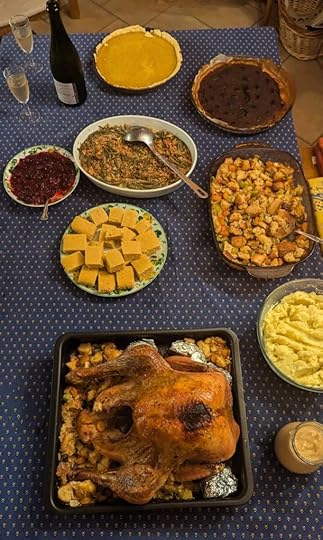
In the end the meal turned out wonderfully well, thanks to many cooks. Even our French neighbors who were coming to their first Thanksgiving meal had somehow heard (or been told? but not by us) about the potluck nature of Thanksgiving meals. They brought little crabmeat verrines for our apéro, providing a lovely French accent to the meal, and also some to-die-for chocolate truffles for dessert. In between apéro and dessert we had turkey/stuffing/gravy; mashed potatoes; green bean casserole; cranberry sauce; cornbread; and two kinds of pie (pumpkin and pecan). Everything, in short, but the sweet potato casserole that American friends in a nearby town were going to bring but couldn’t at the last minute because one of them got sick. 
We did our now “ancient” (three-year) tradition of writing what we were grateful for on slips of paper that we then drew out of the “gratitude vessel” and read aloud–trying to guess which person was grateful for each of the sentiments expressed, accompanied with much laughter and warm feeling.
And of course there was champagne: this year our chosen champagne was Nathalie Nourissat, made by good friends and vignerons who live in Essoyes, and it drew praise all around.
We did not read a Thanksgiving poem this year but if you’re looking for one, here’s one of my favorites. (Along with the poet I repeat, and repeat: “Bless the world outside these windows…Dear God, grant to the makers and keepers power to save it all…”)
Wishing one and all a Happy Thanksgiving, for all we have to be thankful for.
Janet Hulstrand is an American writer/editor who lives in France. She is the author of Demystifying the French: How to Love Them, and Make Them Love You, and A Long Way from Iowa: From the Heartland to the Heart of France.
November 10, 2024
Armistice Day/Veterans Day 2024

It’s been called Veterans Day in the United States since 1954. But it was originally called Armistice Day, and the date on which we remember the veterans of all wars was originally chosen because it is the day on which Germany surrendered to the Allies at the end of World War I, in 1918.
It is still called Armistice Day in France, where most of the fighting was done in that bloody war, and it is a solemn day to remember the costs of war, and those who gave their lives fighting pour la France.
Millions of lives, most of them young lives, have been lost in battle. Every veteran killed has family and friends who mourn that loss. Every veteran who managed to come home came home forever changed, and chastened by what they saw and experienced at war.
Almost all of us regret the loss of the talent, courage, and promise that went into the graves with those young lives.
Today we pay tribute to them, and honor the sacrifices they made to protect freedom, decency, democracy. We can never thank them enough. We can only do all we can, each of us, to find ways to protect and honor those same ideals.
 Flying Officer Charles E. Anderson, Royal Canadian Air Force. Killed in action August 5, 1944 in France
Flying Officer Charles E. Anderson, Royal Canadian Air Force. Killed in action August 5, 1944 in France
 Lt. Howard Season, US Army Air Corps
Lt. Howard Season, US Army Air Corps Missing in Action, Presumed Dead August 1944
Two of my uncles lived long and honorable lives after their military service in World War II. You can read their war stories in the links provided.
 One American Veteran’s D-Day Story
One American Veteran’s D-Day Story
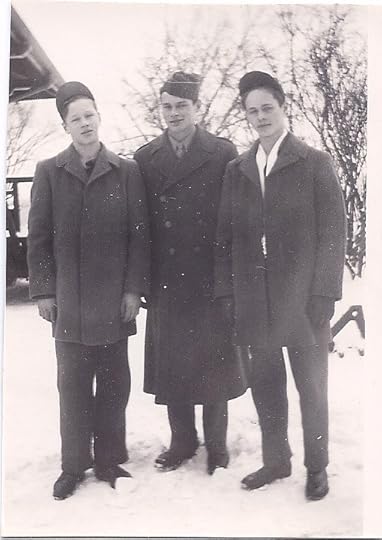 One American Veteran’s Memory of the Battle of the Bulge
One American Veteran’s Memory of the Battle of the BulgeThese sacrifices have not been forgotten in France. Let’s not any of us forget.
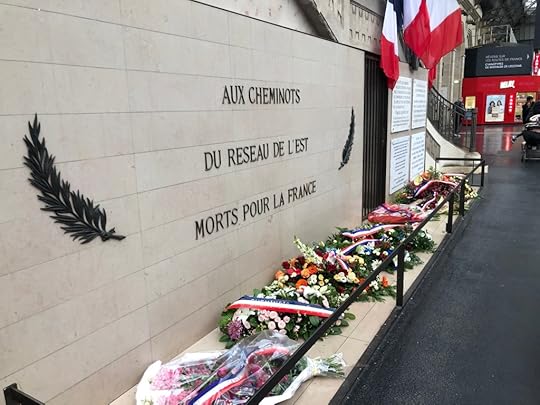
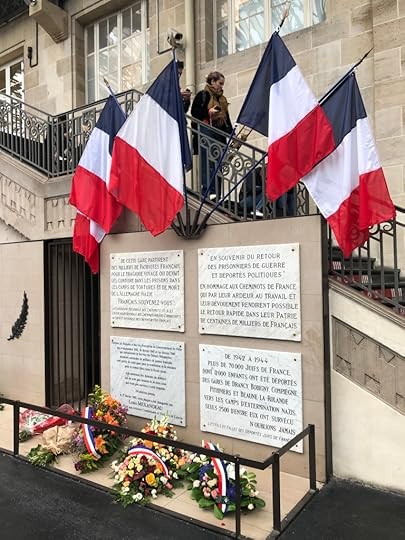 Remembering Armistice Day in France. Gare de l’Est, Nov 10, 2024
Remembering Armistice Day in France. Gare de l’Est, Nov 10, 2024Janet Hulstrand is an American writer/editor who lives in France. She is the author of Demystifying the French: How to Love Them, and Make Them Love You, and A Long Way from Iowa: From the Heartland to the Heart of France.



